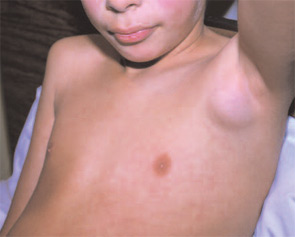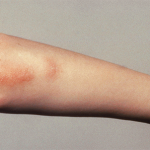Intra-articular steroids are frequently used for children with only a few joints involved. In the case of multiple joint involvement, multiple joints may be injected when they are particularly problematic or interfering with function. Injections can be time consuming by interrupting a busy clinic for procedures, or having to be performed under anesthesia or performed by interventional radiology. However, for the majority of patients, steroid injections are very effective and can be repeated multiple times per year in a specific joint.
Oral prednisone/prednisolone can be particularly effective in gaining control of polyarthritis while other disease-modifying antirheumatic drugs are becoming effective. Start with a 0.5–1 mg/kg/day dose for several weeks, with gradual taper to 0.15 mg/day for several months; this does not appear to result in long-term toxicity. Patients and their families must be counseled about potential weight gain or behavioral abnormalities and the need for extra calcium and vitamin D. Recent investigations point to active disease – rather than low-dose steroid use – as the strongest predictor of osteoporosis.
If a patient is hospitalized, IV pulse methylprednisolone (30 mg/kg/day for three days with 1-gram maximum) can quickly decrease disease activity. Many patients will benefit from weekly outpatient infusions while other medications begin to be effective.

Methotrexate
This is still the mainstay of therapy for the majority of children with JIA. After administration, methotrexate (MTX) has a relatively short half-life in plasma; 80% to 90% of methotrexate is cleared by the kidneys in less than 24 hours. Because children with JIA usually have excellent glomerular filtration, MTX is cleared rapidly.
The single weekly doses of MTX found to be effective in children, 0.3–1.0 mg/kg (10–30 mg/m2), are higher than weekly doses usually reported for adult patients. The route of administration is an important factor for children, because these doses are in the range in which oral MTX becomes increasingly less well absorbed: 0.3 mg/kg (≥10 mg/m2). For children, absorption is best when MTX is given without food. The amount of MTX absorbed by children has wide interpatient variability. For these reasons, subcutaneous administration may be more effective than oral MTX. Experience leads many clinicians to change to subcutaneous MTX at dosages of 0.5 mg/kg or higher, for better absorption and fewer gastrointestinal (GI) side effects. Parents and teenagers can easily be taught to administer subcutaneous MTX at home. A parenteral solution of MTX (25 mg/ml) taken orally is commonly used for pediatric patients when liquid oral dosing is desired.
